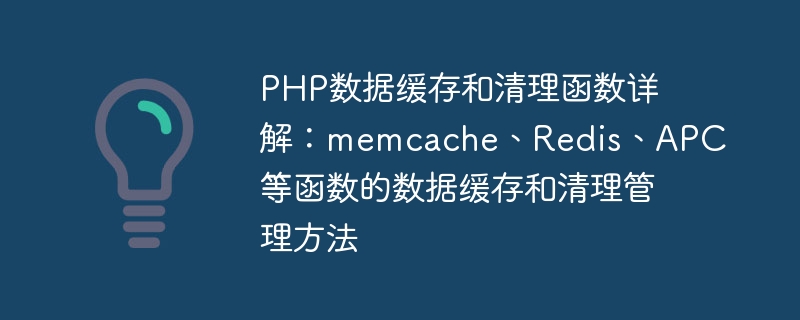Home >Backend Development >PHP Tutorial >Detailed explanation of PHP data caching and cleaning functions: data caching and cleaning management methods for memcache, Redis, APC and other functions
Detailed explanation of PHP data caching and cleaning functions: data caching and cleaning management methods for memcache, Redis, APC and other functions
- PHPzOriginal
- 2023-11-18 09:08:30829browse

Detailed explanation of PHP data caching and cleaning functions: Data caching and cleaning management methods for memcache, Redis, APC and other functions
Introduction:
In PHP development, Data caching and cleaning is a very important part. Reasonable use of cache can improve website performance, and the cleanup management function can help us release occupied memory resources in a timely manner. This article will introduce in detail the commonly used caching components memcache, Redis, and APC in PHP, as well as their data caching and cleaning management methods, and provide specific code examples.
1. Memcache caching system
- Data caching:
It is very simple to use Memcache for data caching in PHP. We first need to connect to the Memcache server and set or get data. The following is an example of setting and getting cached data:
// 连接到Memcache服务器
$memcache = new Memcache;
$memcache->connect('localhost', 11211);
// 设置缓存数据
$memcache->set('key', 'value', false, 3600);
// 获取缓存数据
$value = $memcache->get('key');- Data cleaning:
In order to effectively manage memory, we need to regularly clean up expired data in Memcache. The following is an example of cleaning expired data:
// 连接到Memcache服务器
$memcache = new Memcache;
$memcache->connect('localhost', 11211);
// 清理过期数据
$memcache->flush();2. Redis cache system
- Data cache:
Redis is a high-performance key-value storage system. The same can be used for PHP data caching. We first need to connect to the Redis server and set or get data. The following is an example of setting and getting cached data:
// 连接到Redis服务器
$redis = new Redis;
$redis->connect('localhost', 6379);
// 设置缓存数据
$redis->set('key', 'value');
$redis->expire('key', 3600);
// 获取缓存数据
$value = $redis->get('key');- Data cleaning:
Redis provides the function of automatically cleaning expired data, and we do not need to do it manually. You can use the expiration time feature of Redis to specify the expiration time when setting the data, and Redis will automatically clean up the expired data. The following is an example:
// 连接到Redis服务器
$redis = new Redis;
$redis->connect('localhost', 6379);
// 设置缓存数据,并指定过期时间
$redis->set('key', 'value', 3600);
// 不需要手动清理过期数据3. APC cache system
- Data cache:
APC is an open source PHP cache. We can use the APC cache function to cache data. The following is an example of setting and getting cached data:
// 设置缓存数据
apc_store('key', 'value', 3600);
// 获取缓存数据
$value = apc_fetch('key');- Data cleaning:
APC provides an interface for cleaning cached data. We can use the apc_delete function for data cleaning. The following is an example:
// 清理缓存数据
apc_delete('key');Conclusion:
Through the introduction of this article, we have learned about the data caching and cleaning management methods of memcache, Redis, and APC, the cache components commonly used in PHP, and also provided Specific code examples. Reasonable use of data caching and cleaning operations can improve website performance and effectively manage memory resources. I hope this article will be helpful to your data caching and cleaning operations in PHP development.
The above is the detailed content of Detailed explanation of PHP data caching and cleaning functions: data caching and cleaning management methods for memcache, Redis, APC and other functions. For more information, please follow other related articles on the PHP Chinese website!
Related articles
See more- How to use foreach in PHP
- How to Chineseize phpstorm
- Cache management with PHP and Memcached
- How to use MySQL's event scheduler to implement scheduled data cleaning
- How to use PHP to develop the data cleaning function of the accounting system - Provides a development guide for the data cleaning function

